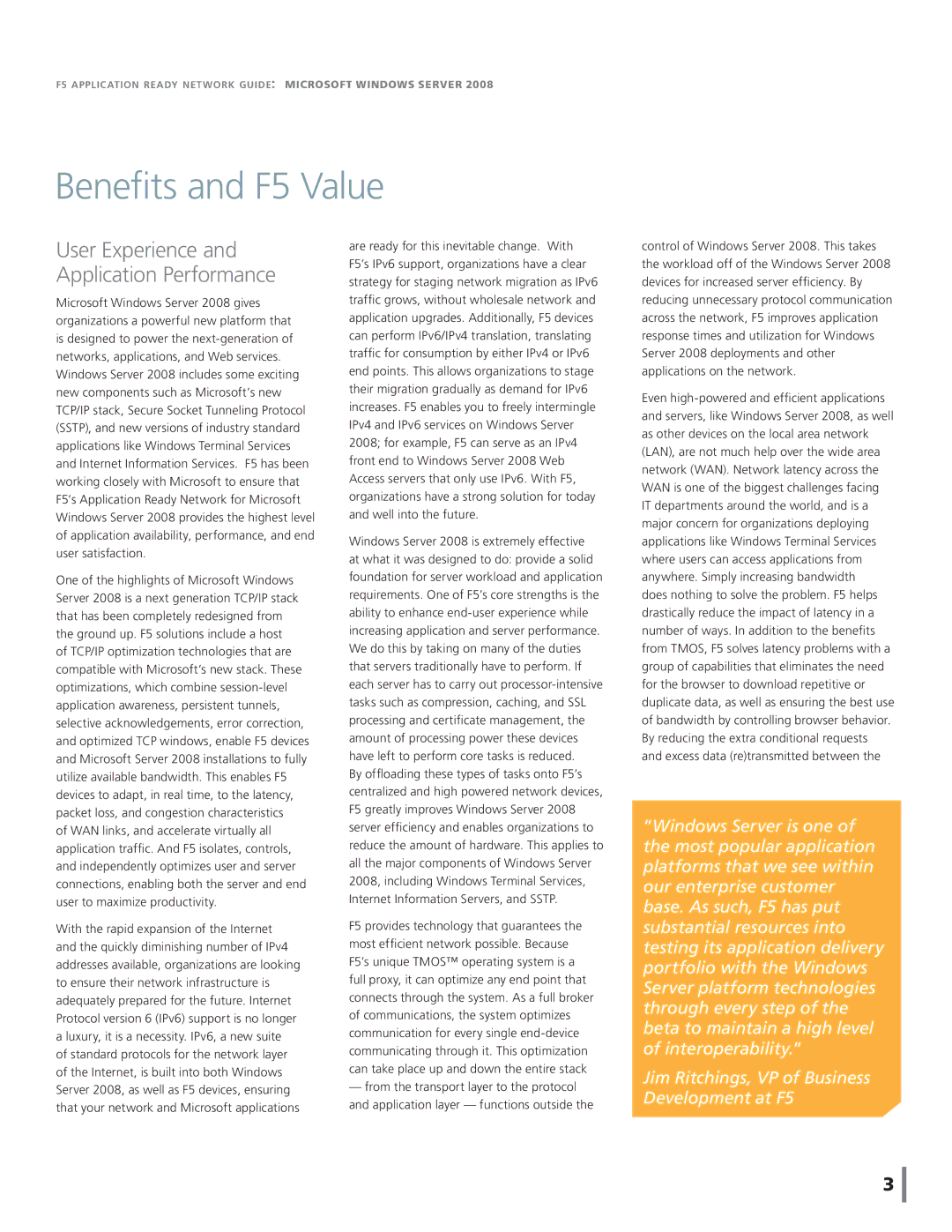
F5 APPLICATION READY NETWORK GUIDE: MICROSOFT WINDOWS SERVER 2008
Benefits and F5 Value
User Experience and Application Performance
Microsoft Windows Server 2008 gives organizations a powerful new platform that is designed to power the
One of the highlights of Microsoft Windows Server 2008 is a next generation TCP/IP stack that has been completely redesigned from the ground up. F5 solutions include a host of TCP/IP optimization technologies that are compatible with Microsoft’s new stack. These optimizations, which combine
of WAN links, and accelerate virtually all application traffic. And F5 isolates, controls, and independently optimizes user and server connections, enabling both the server and end user to maximize productivity.
With the rapid expansion of the Internet and the quickly diminishing number of IPv4 addresses available, organizations are looking to ensure their network infrastructure is adequately prepared for the future. Internet Protocol version 6 (IPv6) support is no longer a luxury, it is a necessity. IPv6, a new suite of standard protocols for the network layer of the Internet, is built into both Windows Server 2008, as well as F5 devices, ensuring that your network and Microsoft applications
are ready for this inevitable change. With F5’s IPv6 support, organizations have a clear strategy for staging network migration as IPv6 traffic grows, without wholesale network and application upgrades. Additionally, F5 devices can perform IPv6/IPv4 translation, translating traffic for consumption by either IPv4 or IPv6 end points. This allows organizations to stage their migration gradually as demand for IPv6 increases. F5 enables you to freely intermingle IPv4 and IPv6 services on Windows Server 2008; for example, F5 can serve as an IPv4 front end to Windows Server 2008 Web Access servers that only use IPv6. With F5, organizations have a strong solution for today and well into the future.
Windows Server 2008 is extremely effective at what it was designed to do: provide a solid foundation for server workload and application requirements. One of F5’s core strengths is the ability to enhance
By offloading these types of tasks onto F5’s centralized and high powered network devices, F5 greatly improves Windows Server 2008 server efficiency and enables organizations to reduce the amount of hardware. This applies to all the major components of Windows Server 2008, including Windows Terminal Services, Internet Information Servers, and SSTP.
F5 provides technology that guarantees the most efficient network possible. Because F5’s unique TMOS™ operating system is a full proxy, it can optimize any end point that connects through the system. As a full broker of communications, the system optimizes communication for every single
—from the transport layer to the protocol and application layer — functions outside the
control of Windows Server 2008. This takes the workload off of the Windows Server 2008 devices for increased server efficiency. By reducing unnecessary protocol communication across the network, F5 improves application response times and utilization for Windows Server 2008 deployments and other applications on the network.
Even
“Windows Server is one of the most popular application platforms that we see within our enterprise customer base. As such, F5 has put substantial resources into testing its application delivery portfolio with the Windows Server platform technologies through every step of the beta to maintain a high level of interoperability.”
Jim Ritchings, VP of Business Development at F5
3
